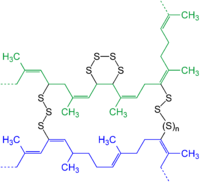
Photo from wikipedia
The inverse electron demand Diels-Alder (iEDDA) reaction between a tetrazine and a strained alkene has been widely explored as useful bioorthogonal chemistry for selective labeling of biomolecules. In this work,… Click to show full abstract
The inverse electron demand Diels-Alder (iEDDA) reaction between a tetrazine and a strained alkene has been widely explored as useful bioorthogonal chemistry for selective labeling of biomolecules. In this work, we exploit the slow reaction between a non-conjugated terminal alkene and a tetrazine, and apply this reaction to achieving a proximity-enhanced protein crosslinking. In one protein subunit, a terminal alkene-containing amino acid was site-specifically incorporated in response to an amber nonsense codon. In another protein subunit, a tetrazine moiety was introduced through the attachment to a cysteine residue. Fast protein crosslinking was achieved due to a large increase in effective molarity of the two reactants that were brought to close proximity by the two interacting protein subunits. Such a proximity-enhanced protein crosslinking is useful for the study of protein-protein interactions.
Journal Title: Bioorganic chemistry
Year Published: 2023
Link to full text (if available)
Share on Social Media: Sign Up to like & get
recommendations!